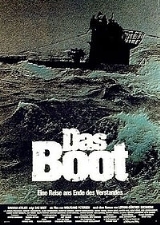Das Boot is a 1981 German
epicAn epic is a genre of film that emphasizes human drama on a grand scale. Epics are more ambitious in scope than other film genres, and their ambitious nature helps to differentiate them from similar genres such as the period piece or adventure film...
war filmWar films are a film genre concerned with warfare, usually about naval, air or land battles, sometimes focusing instead on prisoners of war, covert operations, military training or other related subjects. At times war films focus on daily military or civilian life in wartime without depicting battles...
writtenA screenplay or script is a written work that is made especially for a film or television program. Screenplays can be original works or adaptations from existing pieces of writing. In them, the movement, actions, expression, and dialogues of the characters are also narrated...
and
directedA film director is a person who directs the actors and film crew in filmmaking. They control a film's artistic and dramatic nathan roach, while guiding the technical crew and actors.-Responsibilities:...
by
Wolfgang PetersenWolfgang Petersen is a German film director and screenwriter. His films include The NeverEnding Story, Enemy Mine, Outbreak, In the Line of Fire, Air Force One, The Perfect Storm, Troy, and Poseidon...
, produced by Günter Rohrbach, and starring
Jürgen ProchnowJürgen Prochnow is a German actor. His most well-known roles internationally have been as the sympathetic submarine captain in Das Boot , Duke Leto Atreides I in Dune , the minor, but important role of Neo-Stalinist dictator General Ivan Radek in Air Force One and the villain Maxwell Dent in...
,
Herbert GrönemeyerHerbert Grönemeyer is a German musician and actor, popular in Germany, Austria and Switzerland. He starred as war correspondent Lieutenant Werner in Wolfgang Petersen's movie Das Boot, but later concentrated on his musical career...
, and
Klaus WennemannKlaus Wennemann was a German actor. He was best known for his roles as the Chief Engineer in Das Boot and as Faber in the TV series Der Fahnder. He died at the age of 59 from lung cancer....
. It has been exhibited both as a theatrical release and as a TV
miniseriesA miniseries , in a serial storytelling medium, is a television show production which tells a story in a limited number of episodes. The exact number is open to interpretation; however, they are usually limited to fewer than a whole season. The term "miniseries" is generally a North American term...
, and in several different
home videoHome video is a blanket term used for pre-recorded media that is either sold or rented/hired for home cinema entertainment. The term originates from the VHS/Betamax era but has carried over into current optical disc formats like DVD and Blu-ray Disc and, to a lesser extent, into methods of digital...
versions of various running times.
Das Boot is an adaption of the 1973 German novel of the same name by
Lothar-Günther BuchheimLothar-Günther Buchheim was a German author and painter. He is best known for his novel Das Boot , which became an international bestseller and was adapted in 1981 as an Oscar-nominated film.-Early life:...
. Set during World War II, the film tells the fictional story of U-96 and its crew.

![]()
![]()
![]()
![]()
![]()
![]()

